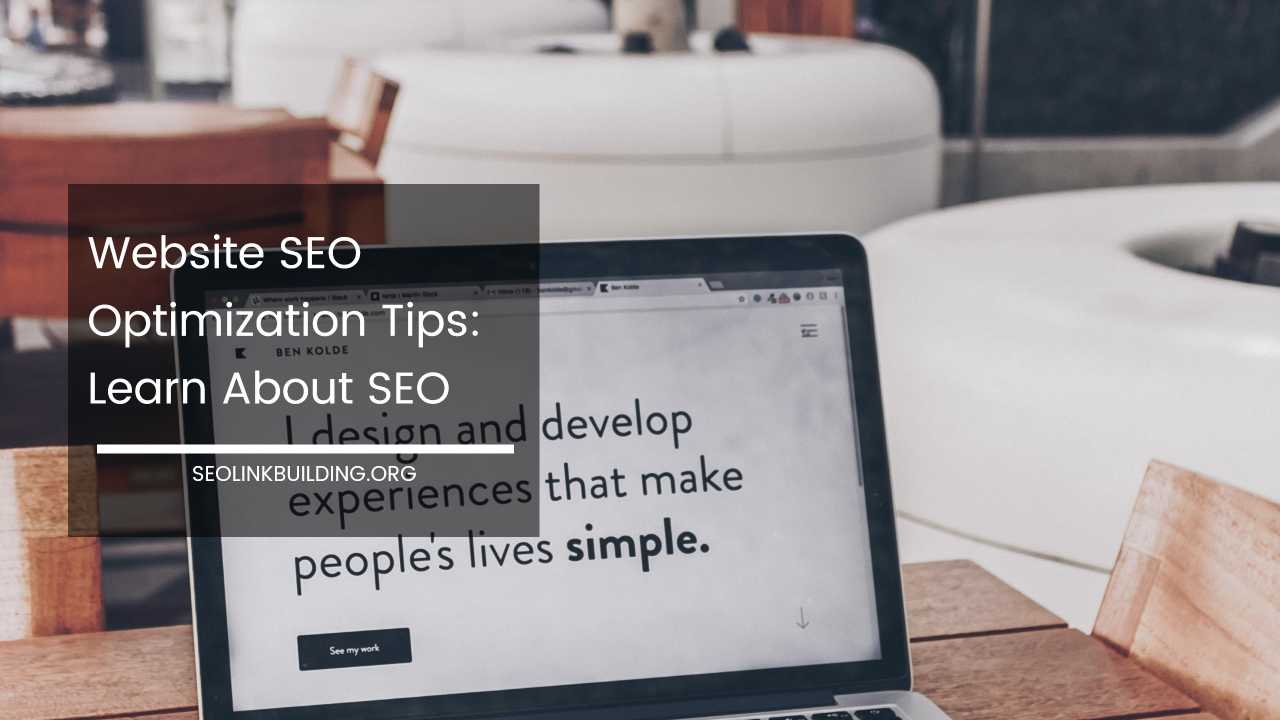SEO & UX: The Ultimate Guide to Website Optimization

Guide To Optimizing a Website: Attract, Engage, and Convert (2000 Words)
In today’s digital age, your website is the lifeblood of your online presence. It’s the virtual storefront where you showcase your brand, the interactive brochure that informs your audience, and the tireless salesperson that converts visitors into customers.
A well-optimized website excels in all these areas, attracting new traffic, fostering meaningful interactions, and ultimately driving conversions.
This comprehensive guide equips you with the knowledge and strategies to optimize your website for both search engines and users.
By mastering this two-pronged approach, you’ll propel your website towards achieving your online goals, be it increased brand awareness, lead generation, or booming sales.
Understanding Website Optimization
Website optimization is the ongoing process of fine-tuning your website’s performance across various metrics. It’s a strategic dance with two key partners:
- Search Engine Optimization (SEO): The art and science of making your website more visible in search engine results pages (SERPs) for relevant keywords. This increases your organic traffic, the lifeblood of any successful website.
- User Experience (UX): The focus on creating a user-friendly and engaging website that fosters positive interactions and conversions. Think of it as crafting a welcoming environment that keeps visitors glued to your content and compels them to take desired actions.
Optimizing for Search Engines: Speak the Search Engine Language
Search engines like Google rely on complex algorithms to crawl, index, and rank websites. By implementing SEO best practices, you can increase your website’s crawlability and relevance, leading to higher search rankings and organic traffic.
-
Keyword Research: Uncover the Words Your Audience Craves – Identifying the right keywords is like deciphering a secret code to unlock website visibility. Utilize keyword research tools like Google Keyword Planner, Ahrefs, or SEMrush to discover high-volume, low-competition keywords relevant to your niche. Don’t just focus on broad keywords; explore long-tail keywords that represent more specific search intents.
-
On-Page Optimization: Infuse Your Content with Keyword Magic – Once you’ve identified your target keywords, integrate them naturally throughout your website’s content. Don’t resort to keyword stuffing, as search engines penalize such practices. Instead, weave your keywords into titles, meta descriptions, headers (H1, H2, etc.), image alt tags, and the body content itself. However, prioritize user readability – content should flow naturally and provide genuine value to your audience.
-
Content is King (and Queen): Create Content that Captivates – High-quality content is the cornerstone of any successful SEO strategy. Focus on creating informative, engaging, and valuable content that addresses your audience’s needs and search intent. Whether it’s blog posts, informative articles, compelling product descriptions, or captivating videos, ensure your content is well-written, informative, and optimized for your target keywords.
-
Technical SEO: The Behind-the-Scenes Hero – A technically sound website is crucial for optimal SEO performance. Here’s what to consider:
- Mobile-friendliness: In today’s mobile-first world, your website must adapt seamlessly to different screen sizes, particularly mobile devices. Utilize Google’s Mobile-Friendly Test to assess your website’s mobile responsiveness and identify areas for improvement.
- Fast Loading Speed: A slow website is the enemy of both search engines and users. Studies show that users abandon websites that take longer than 3 seconds to load. Optimize your website for speed by compressing images, minifying code, leveraging browser caching, and utilizing a reliable web hosting service. Tools like Google PageSpeed Insights and GTmetrix can help analyze and diagnose speed issues.
- Clean Code Structure: A clean and well-structured code base makes it easier for search engines to crawl and index your website. This includes factors like a logical URL structure, use of semantic HTML elements, and a properly configured robots.txt file.
- Secure Connection (HTTPS): Ensure your website uses a secure HTTPS connection. This not only protects user data but also acts as a positive SEO ranking factor.
-
Backlink Building: Earn Credibility with Valuable Links – Backlinks are essentially votes of confidence from other websites to yours. Earning backlinks from high-authority websites in your niche signals trust and relevance to search engines, boosting your website’s ranking potential. Focus on creating high-quality content that others will want to link to naturally. You can also explore guest blogging opportunities on relevant websites or participate in online communities to build relationships and earn organic backlinks.
Optimizing for User Experience: Craft an Experience that Delights
A user-friendly website not only keeps visitors engaged but also encourages them to take desired actions, such as making a purchase, subscribing to a newsletter, or contacting you. Here’s how to prioritize user experience (UX) in your website optimization strategy:
-
Website Structure and Navigation: Chart a Clear Course – Craft a clear and intuitive website structure. Users should be able to find the information they need with minimal clicks. Imagine your website as a well-organized store – categories and subcategories should be logical and easy to navigate. Employ clear and concise navigation menus, breadcrumbs, and internal linking strategies to guide users through your website.
-
Website Design: Aesthetics that Captivate and Convert – Prioritize a visually appealing and user-friendly design. First impressions matter, and a visually attractive website sets a positive tone for user interaction.
- High-Quality Images and Visuals: Incorporate high-quality images, infographics, and videos that are relevant to your content and visually appealing. Humans are visual creatures, and captivating visuals can enhance user engagement and understanding.
- Consistent Branding Elements: Maintain consistent branding elements throughout your website, including your logo, color palette, and fonts. This fosters brand recognition and creates a sense of trust and professionalism.
- White Space and Readability: Don’t clutter your website. Utilize ample white space to create a clean and uncluttered look. This improves readability and prevents users from feeling overwhelmed.
-
Mobile Optimization: Cater to the On-the-Go Audience – Ensure your website is responsive and adapts seamlessly to different screen sizes, particularly mobile devices. With the ever-increasing use of smartphones and tablets, a mobile-friendly website is no longer an option; it’s a necessity. Test your website across various mobile devices to identify and rectify any responsiveness issues.
-
Fast Loading Speed: Respect User Time – A slow website can lead to high bounce rates (users leaving your website shortly after arriving). Optimize your website for speed by implementing the same strategies mentioned in the SEO section (compressing images, minifying code, etc.). Every second counts in the digital world, so ensure your website loads quickly and efficiently.
-
Content Readability: Make Your Content Shine – Format your content for easy readability. This includes:
- Subheadings: Break up large chunks of text with clear and concise subheadings. This improves scannability and guides users through the content.
- Bullet Points and Lists: Utilize bullet points and numbered lists to present complex information in a digestible way.
- Short Paragraphs: Opt for shorter paragraphs to improve readability and prevent user fatigue.
- Clear Calls to Action (CTAs): Tell users what you want them to do next. Whether it’s “Subscribe to Our Newsletter” or “Shop Now,” craft clear and compelling CTAs that guide users towards desired actions.
-
Accessibility: Open the Door for All Users – Make your website accessible to users with disabilities by incorporating features like:
- Alt Text for Images: Provide descriptive alternative text (alt text) for all images on your website. This helps visually impaired users understand the content of the image.
- Proper Color Contrast: Ensure adequate color contrast between text and background colors. This improves readability for users with visual impairments.
- Keyboard Navigation: Your website should be fully navigable using just the keyboard, catering to users who rely on assistive technologies.
Advanced Website Optimization Techniques: Digging Deeper
Once you’ve mastered the fundamentals of SEO and UX optimization, explore these advanced techniques to further refine your website’s performance:
-
Website Heatmaps and Session Recordings: Gain valuable insights into user behavior by utilizing heatmaps and session recordings. Heatmaps visually represent where users click and scroll on your website, while session recordings show their entire journey. Analyze this data to identify areas of user frustration and optimize your website for better user flow and engagement.
-
A/B Testing: The Science of Refinement – Don’t settle for assumptions; test different website elements like headlines, CTAs, page layouts, and design elements to determine what resonates best with your audience and drives conversions. A/B testing allows you to compare two variations of a webpage and see which one performs better. This data-driven approach helps you continuously refine your website and user experience.
Optimizing for Voice Search: The Rise of Conversational Search
The way people search for information is evolving. Voice search, powered by virtual assistants like Siri and Google Assistant, is becoming increasingly popular. Optimize your website for voice search by:
- Using Long-Tail Keywords: People tend to use longer, more conversational phrases when conducting voice searches. Integrate long-tail keywords that answer specific questions your target audience might ask.
- Focusing on Conversational Language: Craft website content that mirrors natural human speech patterns. Instead of stiff, formal language, use conversational phrases and answer questions in a clear and concise way.
- Prioritizing Local SEO: If your business has a physical location, optimize your website for local voice search. Ensure your Google My Business profile is complete and up-to-date, including your address, phone number, and business hours.
Content Marketing: Fueling Your Website’s Growth
A website without valuable content is like a store with empty shelves. Content marketing is the strategic creation and distribution of valuable, relevant, and consistent content to attract and retain a clearly defined audience. Here’s how it fuels website optimization:
- Establish Yourself as a Thought Leader: Create informative and insightful blog posts, articles, or videos that address your target audience’s pain points and interests. By positioning yourself as a thought leader in your niche, you attract organic traffic and build trust with potential customers.
- Improve Search Engine Ranking: Fresh, high-quality content is a positive signal for search engines. Regularly publishing content keeps your website active and relevant, potentially boosting your search engine rankings and driving organic traffic.
- Increase User Engagement: Compelling content keeps users engaged on your website for longer periods. This not only improves user experience but also increases the likelihood of conversions.
- Drive Social Media Engagement: Promote your content on social media platforms to reach a wider audience and drive traffic back to your website.
Measuring and Analyzing Your Website’s Performance
Website optimization is an ongoing process. To ensure you’re on the right track, regularly monitor and analyze your website’s performance using various analytics tools:
- Google Search Console: This free tool by Google provides valuable insights into your website’s search performance, including organic traffic sources, keyword rankings, and technical SEO issues.
- Google Analytics: A powerful tool for tracking website traffic, user behavior, and conversions. Analyze data like page views, bounce rates, time on site, and user demographics to understand how visitors interact with your website and identify areas for improvement.
- Website Speed Testing Tools: Tools like Google PageSpeed Insights and GTmetrix analyze your website’s loading speed and offer recommendations for improvement.
- Heatmaps and Session Recording Tools: Gain valuable insights into user behavior by using heatmaps and session recordings to see where users click, scroll, and drop off.
Continuously Monitor and Improve: The Never-Ending Journey
Website optimization is a marathon, not a sprint. By constantly monitoring your website’s performance, analyzing user behavior, and staying updated on the latest trends, you can continuously refine your website to achieve your goals.
- Stay Updated on SEO Trends: The world of SEO is constantly evolving. Stay updated on the latest algorithm updates and industry best practices to ensure your website remains search-engine friendly.
- Refresh and Update Your Content: Content is king, but it needs to be fresh and relevant. Regularly update your existing content and create new content to keep users engaged and improve search engine ranking.
- Embrace A/B Testing: Don’t be afraid to experiment! A/B testing allows you to test different website elements and see what resonates best with your audience. This data-driven approach helps you continuously improve conversions and user experience.
Final Thoughts: Building a Website that Thrives
By implementing a strategic website optimization plan that prioritizes both search engines and user experience, you can create a website that attracts new visitors, keeps them engaged, and ultimately converts them into loyal customers.
Remember, website optimization is an ongoing process. Embrace a data-driven approach, continuously learn and adapt, and your website will become a powerful tool for achieving your online goals.













